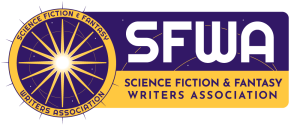by Michael Armstrong
Starting in 1965, the Science Fiction and Fantasy Writers Association trophies have evolved from the original Nebula Award of spheres and spiral galaxies encased in Lucite to newer awards such as the Kate Wilhelm Solstice Award of a butterfly and compass. One award, the Infinity Award, honoring Grand Master-worthy writers who died before they could be selected, didn’t even have a physical trophy until this year.
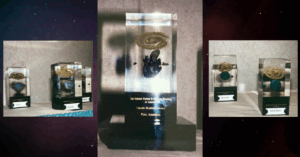
Several Nebula Awards trophies displayed before being awarded at the 1998 Nebula Awards banquet held in Santa Fe, New Mexico. Note the large quartz crystal. Photos by Michael Armstrong.
At its annual conference, SFWA gives out these awards:
- Nebula Award for Novel
- Nebula Award for Novella
- Nebula Award for Novelette
- Nebula Award for Short Story
- Nebula Award for Game Writing
- Ray Bradbury Nebula Award for Outstanding Dramatic Presentation
- Andre Norton Nebula Award for Middle Grade and Young Adult Fiction
- Damon Knight Memorial Grand Master Award
- Kevin O’Donnell, Jr. Service to SFWA Award
- Kate Wilhelm Solstice Award
- Infinity Award
Beginning in 2026, two new awards will be added to this list:
- Nebula Award for Speculative Comics
- Nebula Award for Speculative Poetry
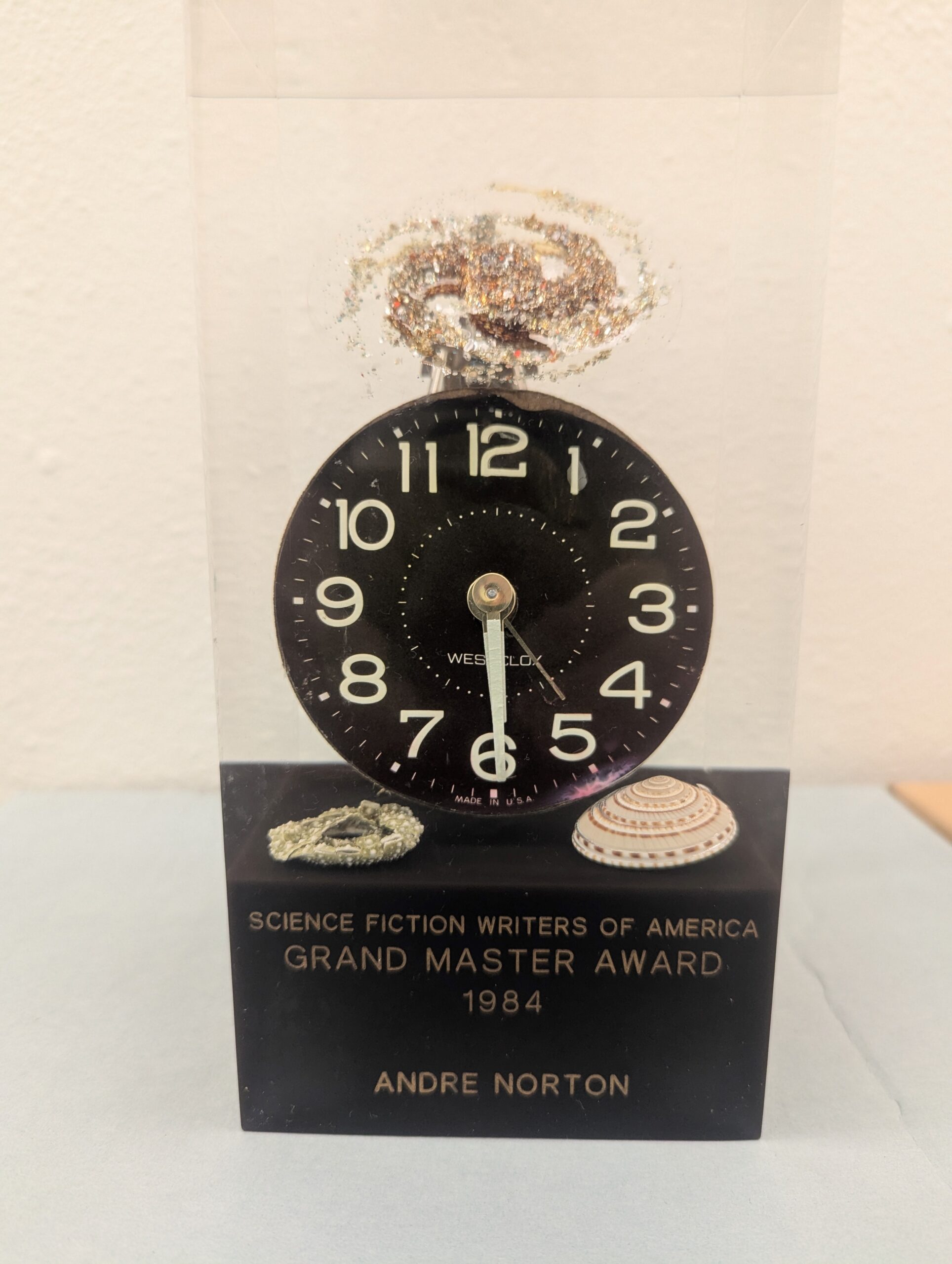
According to Damon Knight, the first SFWA president and one of its founders, Kate Wilhelm sketched the original concept for the Nebula Award, with Judith Blish designing the trophy. Except for the Ray Bradbury and Andre Norton awards, the Nebula Awards consist of a black lucite base and a clear lucite slab with the nebula spiral galaxy design and spherical lapis lazuli, chrysocolla, and other minerals that look like floating planets. The trophy size has varied over the years from about eight to nine inches high, four to five inches wide, and three to five inches thick. The Grand Master award has a slightly larger and tapered base but includes the same top as the Nebulas.
The first Nebula Awards had quartz crystals and even objects such as pocket watches. Alan Dean Foster and William Rotsler selected gems for the Nebula awards in the early years. When quartz crystals became expensive due to New Age theories of their healing powers, Rotsler added the spheres.
In the 1990s, when I was the Nebula Awards rocks wrangler—the title of the volunteer who acquired the elements—I added objects like meteorites and titanium-coated crystals, shiny rocks a friend would pick up at the Tucson Gem and Mineral Show. In recent years, former SFWA executive director Kate Baker and, later, former deputy executive director Terra LeMay have been the rocks wranglers.
Baker said recent trophies have stuck to using the spherical stones. “In order to make them more uniform to prevent material sourcing and production issues, while still preserving uniqueness of each award, I moved to different-sized and different-colored spherical gemstones,” she wrote in an email.
The Bradbury Award takes a different approach. Texas artist Vincent Villafranca designed and cast in bronze the sculpture of a person with an IBM Selectric typewriter ball head taking a hammer to a pyramid and standing on a book base. Villafranca also designed the Hugo Award base for the San Antonio Worldcon and recently did the redesign of the World Fantasy Award.
The Andre Norton award previously had a taller, obelisk shape with a glittery spiral tube embedded, but in 2020, Baker said it was redesigned to be the same as other Nebula awards.
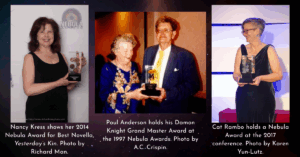
Fans of Stanley Kubrick’s 2001: A Space Odyssey will appreciate the simple design of the Kevin O’Donnell Jr. Service to SFWA Award, a black monolith. Named after one of SFWA’s most tireless volunteers, the Service to SFWA Award honors members who have contributed to the organization through long-term service. The front is clear lucite with the nebula glitter pattern against a black back, but looked at from the rear, it could be a prop for Kubrick’s classic movie. After I received my award at the 2014 banquet, I amused my tablemates by playing Richard Strauss’s “Thus Spake Zarathustra” on my smartphone.
The Solstice Award recognizes “up to three persons, living or dead, who have consistently had a positive, transformative influence on the genre of science fiction and fantasy,” according to the SFWA website. A collaboration between former SFWA President Mary Robinette Kowal and artist Mike Libby, the Solstice Award consists of a butterfly hovering over a compass and encased in a glass dome.
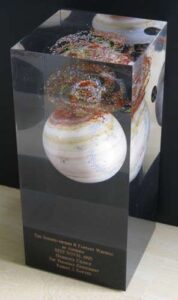
In 2023, SFWA added a new Infinity Award, first given to the late Octavia F. Butler. That award honors writers who died before they could be considered for the Grandmaster award. “This new award aims to recognize that even though those celebrated world builders, storytellers, and weavers of words are no longer with us, their legacies will continue to inspire,” according to the SFWA website.
Unique among SFWA awards, the Infinity Award has had no physical trophy until this year. Instead, SFWA donates to a cause the honoree supported or their loved ones requested. Butler was honored with a donation to the Octavia F. Butler Scholarship to the Clarion West workshop. For the 2024 honoree, Tanith Lee, SFWA donated to the Pasadena Humane Society and the Susan G. Komen Breast Cancer Foundation.
SFWA previously honored living writers who no longer worked in the field with the Author Emeritus award. Baker said former SFWA President Jeffe Kennedy instituted the SFWA Infinity Award in 2023 after the Author Emeritus award fell out of favor.
From time to time, SFWA has also given out special awards, including a SFWA Lifetime Achievement Award in 2001 to Betty Ballantine and a special honoree award in 2013 to Frank M. Robinson by former SFWA President Steven Gould.
Society Awards creates the current trophies, at a cost of about $1,100 for each award, including purchase of minerals and shipping, Baker said. In the event of a tie, extra elements are purchased every year to get a rush-order trophy.
The Nebula Awards have been featured in a few movie and television projects, most recently in the series Mythic Quest.
Explore more articles from THE HISTORY FILES

Michael A. Armstrong was born in Charlottesville, Virginia, and raised in Tampa, Florida. He moved to Anchorage, Alaska, in 1979, and has lived in Homer, Alaska, since 1994. He has a bachelor of arts in humanities from New College of Florida and a master of fine arts in writing from the University of Alaska Anchorage. He also attended the Clarion Science Fiction Writers Workshop. He has written two post-nuclear apocalypse novels, After the Zap and Agviq. He also wrote The Hidden War and Bridge Over Hell. His most recent novel is Truck Stop Earth. His short fiction has been published in Asimov’s, The Magazine of Fantasy and Science Fiction, Analog, Fiction Quarterly, and many anthologies. In 2014, he received the Kevin O’Donnell Jr. Service to SFWA Award.
In 2022, Armstrong retired after working 23 years as a reporter and editor at Homer News, a small weekly newspaper in Homer. He lives in the hills above Homer in a home he built with his wife, Jenny Stroyeck, a partner in the Homer Bookstore. He and Jenny play in Shamwari, one of Homer’s marimba bands. They share their lives with Fletcher, an enormously cute little dog.
